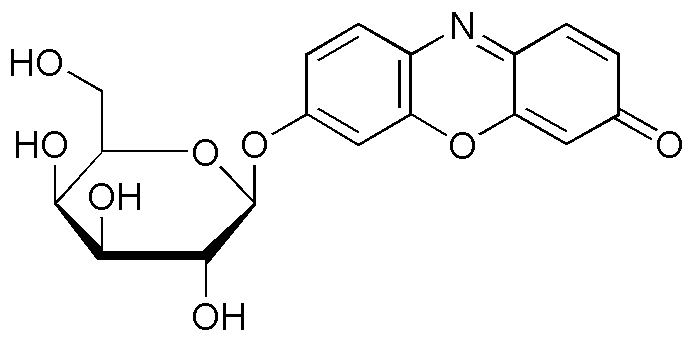Resorufin-b-D-galactopyranoside is widely utilized in research focused on:
- Fluorescent Probes: This compound serves as a valuable fluorescent probe in biochemical assays, allowing researchers to track enzyme activity and cellular processes with high sensitivity.
- Drug Development: It is employed in drug screening assays to evaluate the efficacy of new pharmaceuticals, particularly in targeting glycosylation pathways, which are crucial in many diseases.
- Cellular Imaging: The compound is used in live-cell imaging techniques, enabling scientists to visualize and study cellular dynamics in real-time, which is essential for understanding disease mechanisms.
- Biochemical Research: It plays a significant role in studying carbohydrate metabolism and enzyme kinetics, providing insights into metabolic disorders and potential therapeutic targets.
- Diagnostics: Resorufin-b-D-galactopyranoside can be utilized in diagnostic assays for detecting specific enzymes in clinical samples, aiding in the diagnosis of various health conditions.
General Information
Properties
Safety and Regulations
Applications
Resorufin-b-D-galactopyranoside is widely utilized in research focused on:
- Fluorescent Probes: This compound serves as a valuable fluorescent probe in biochemical assays, allowing researchers to track enzyme activity and cellular processes with high sensitivity.
- Drug Development: It is employed in drug screening assays to evaluate the efficacy of new pharmaceuticals, particularly in targeting glycosylation pathways, which are crucial in many diseases.
- Cellular Imaging: The compound is used in live-cell imaging techniques, enabling scientists to visualize and study cellular dynamics in real-time, which is essential for understanding disease mechanisms.
- Biochemical Research: It plays a significant role in studying carbohydrate metabolism and enzyme kinetics, providing insights into metabolic disorders and potential therapeutic targets.
- Diagnostics: Resorufin-b-D-galactopyranoside can be utilized in diagnostic assays for detecting specific enzymes in clinical samples, aiding in the diagnosis of various health conditions.
Documents
Safety Data Sheets (SDS)
The SDS provides comprehensive safety information on handling, storage, and disposal of the product.
Product Specification (PS)
The PS provides a comprehensive breakdown of the product’s properties, including chemical composition, physical state, purity, and storage requirements. It also details acceptable quality ranges and the product's intended applications.
Certificates of Analysis (COA)
Search for Certificates of Analysis (COA) by entering the products Lot Number. Lot and Batch Numbers can be found on a product’s label following the words ‘Lot’ or ‘Batch’.
*Catalog Number
*Lot Number
Certificates Of Origin (COO)
This COO confirms the country where the product was manufactured, and also details the materials and components used in it and whether it is derived from natural, synthetic, or other specific sources. This certificate may be required for customs, trade, and regulatory compliance.
*Catalog Number
*Lot Number
Safety Data Sheets (SDS)
The SDS provides comprehensive safety information on handling, storage, and disposal of the product.
DownloadProduct Specification (PS)
The PS provides a comprehensive breakdown of the product’s properties, including chemical composition, physical state, purity, and storage requirements. It also details acceptable quality ranges and the product's intended applications.
DownloadCertificates of Analysis (COA)
Search for Certificates of Analysis (COA) by entering the products Lot Number. Lot and Batch Numbers can be found on a product’s label following the words ‘Lot’ or ‘Batch’.
*Catalog Number
*Lot Number
Certificates Of Origin (COO)
This COO confirms the country where the product was manufactured, and also details the materials and components used in it and whether it is derived from natural, synthetic, or other specific sources. This certificate may be required for customs, trade, and regulatory compliance.


